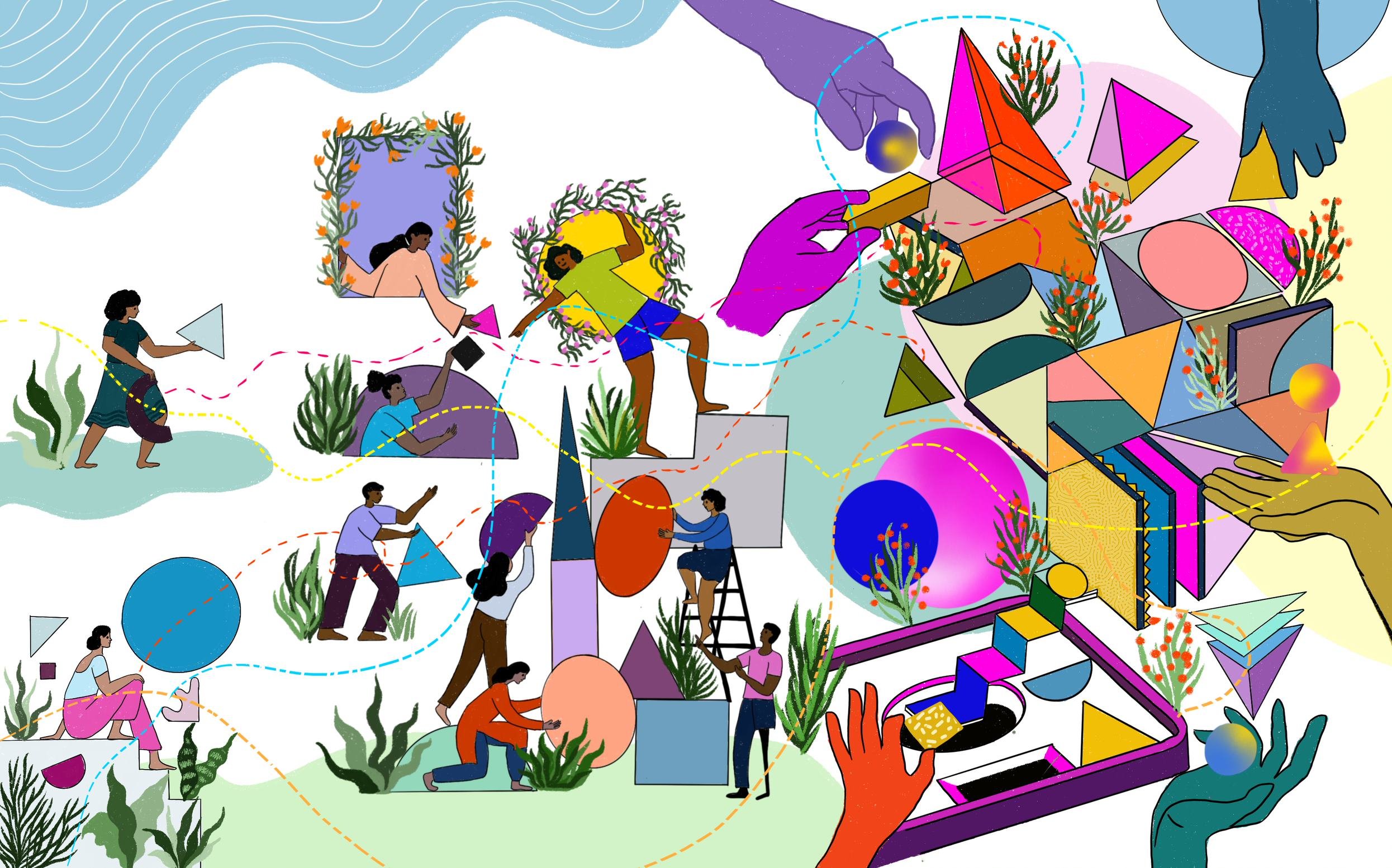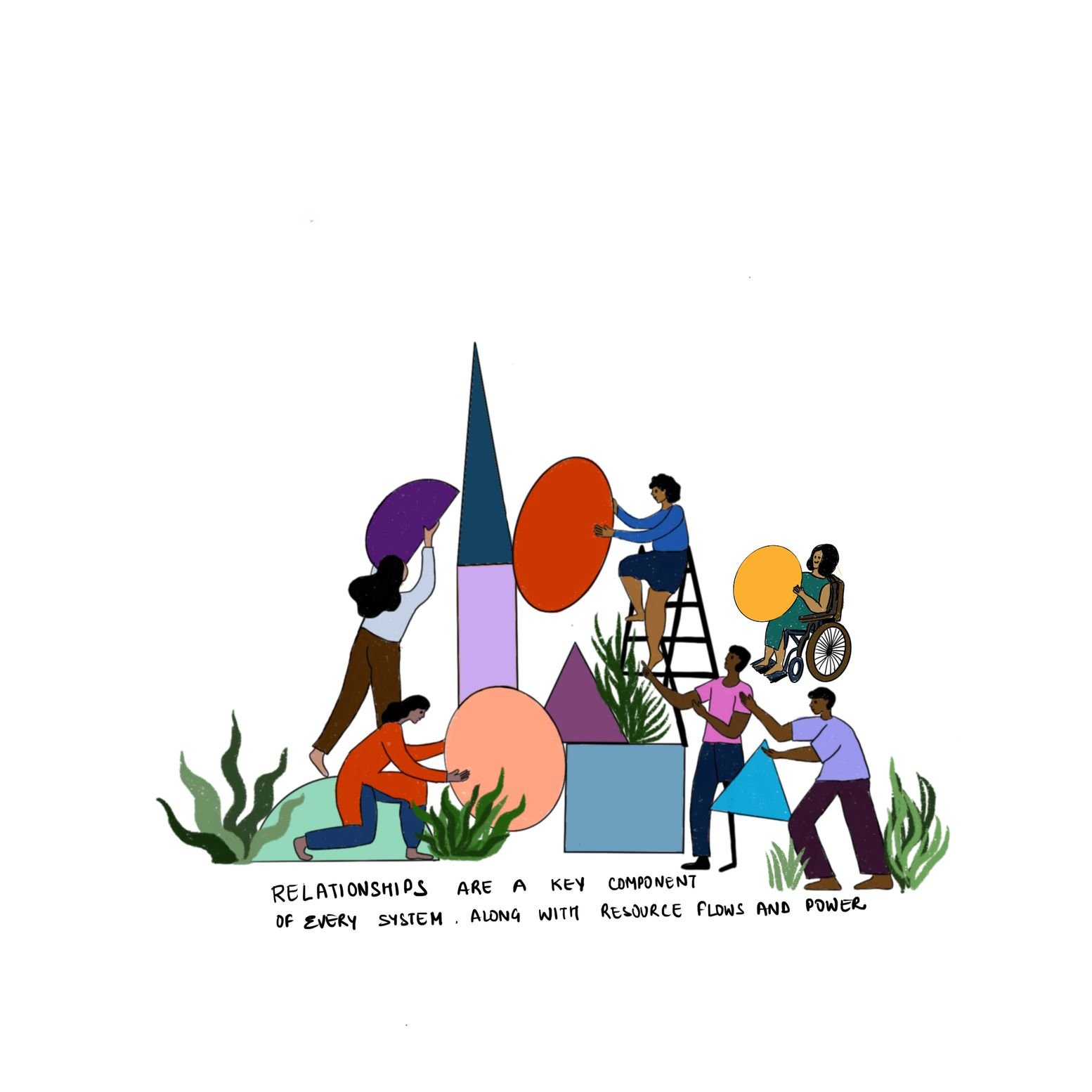Systems Innovation Blog Series - Part One: Systems Innovation
An inside-look at diversifying innovation efforts in international development organizations
By Benjamin Kumpf (OECD), Nina Strandberg (Swedish International Development Cooperation Agency) and Robbie Barkell (UK Foreign, Commonwealth and Development Office). Illustrations by Vidushi Yadav.
*Disclaimer: The views expressed in this blog series are the authors’ own and do not reflect the official positions of their home organizations, and not of the International Development Innovation Alliance.
In this five-part blog post series we share some of our lessons on advancing systems innovation practices in bilateral development organizations. With this, we seek to advance conversations on improving innovation efforts in the international development sector. In this first post, we describe what systems innovation is. In the second post, we make the case for systems innovation. The third post discusses some lessons from international development cooperation that inform our approach. In the fourth post, we present promising practice and building blocks of systems innovation. The final post shares five questions to help advance systems innovation practices in international development organizations.
“If you board the wrong train, it is no use running along the corridor in the other direction.”
(Dietrich Bonhoeffer)
Every day, the Indian railway system moves about 23 million people and approximately 3 million tons of freight across its 115,000 kilometres network. The first train passenger line in the country was opened in 1853, measuring a mere 32 kilometres. The design of the country’s railway system is inextricably linked to technological progress in steam engine technology and rail construction design, pioneered in Britain at the time.
To move a person from one place to another with a train, more than a steam engine on rails is required. The journey of a passenger relies on a whole system to function, from railways as part of the infrastructure and products such as carts to entire value chains for commercial train travel. Technological and social systems pull together different components to produce an outcome.
In technological and social systems, every component has its individual significance. Let’s take the example of a system with a higher degree of complexity: a national health system. For such a system this includes, but is not limited to, educational institutions that train nurses and doctors, health care equipment, hospital buildings and related infrastructure, public health policies, insurance systems and more. The interplay of the different parts creates a system. Systems have a purpose. Overall, the purpose of a health care system is to improve human health. In such a system, the safe delivery of a baby in a clinic can be framed as an outcome. Social and technological systems are interlinked, such as an energy and health systems. Donella Meadows frames systems as “a set of things — people, cells, molecules or whatever — interconnected in such a way that they produce their own pattern of behaviour over time” in her seminal work. Relationships are a key component of every system, along with resource flows and power.
Take the Indian railway system. Its rise is not only linked to technological progress, but also to British colonialism. British mercantile firms were the first influential voices to advocate for railway construction in India, mainly to lower transportation costs, facilitate access to Indian cotton and open the Indian market to British goods. As in other countries, steam powered train systems fuelled economic growth in India, increasing incomes of some population segments and exacerbating deprivations and exclusion for others. A number of Indian academics, including Romesh Dutt, Dadabhai Naoroji and Mahadev Ranade, argue that the railway construction was predominantly beneficial to the British regime and undermined India’s economic growth.
The design and expansion of the railway system in India marked the transformation from one social-technological system to another. The railway system fundamentally altered the infrastructure and economic activity by connecting important ports to industrial and commercial centres in the country. Its advent highlights the dynamic interplay between innovations at the micro-level, such as steam engines technology and railway construction design, with significant societal and economic transformations at the macro-scale, notably industrialization and the advent of capitalism. Such a transformation from one social-technological system to another can be called “systems innovation”.
For systems innovation to happen, the meso-level must play its part. This meso-level consists of the public sector, markets, technologies, the civic space and other institutions that together constitute the structure of a system. “This is the engine room of the system” write Charlie Leadbeater and Jennie Winhall in the Green Paper ‘Building Better Systems’: “To develop a different, better system it is never enough for there to be change at the macro and the micro, there needs to be change at this meso level as well. There may be promising ideas and interesting experiments but without a new regime there is no new system.”
This concept of the meso-level matters for international development and innovation in our sector. Arguably, every development initiative and every innovation investment either strengthens an existing system or seeks to transform it. In rare cases, a new social and technological system emerges and development cooperation can contribute to the rise of a new system, for example a welfare system in a low-income country, a system providing universal health coverage or a formal education system.
Today, a number of social and technological systems such as food, energy and transport systems are globally interconnected and demonstrate a persistent pattern of failure to consider their substantial negative side-effects. Effects of these systems on our natural environment emerge in one place, cascade and impact other parts of the world. Climate change, biodiversity loss and growing social polarizations are examples of catastrophic risks humanity is facing on a global level. The scale of these risks is further enhanced by emerging technologies, which develop faster than our collective ability to assess and manage the impacts on society and the environment.
This year, the global COVID-19 crisis triggered a plethora of promises by governments in high-income countries to build back better, reflecting an acknowledgment of catastrophic risks. But recent research by Vivid Economics found that only about ten per cent of the US$17trillion spent globally on reviving economies was channelled to projects that aim to reduce greenhouse gas emissions or conserving biodiversity. More than US$3 trillion was spent on measures and industries that actively harm the environment, including the coal and other fossil fuel industries.
So if a number of social and technological systems on global and national scales require transformations for humanity to thrive within planetary boundaries, then every development and every development innovation investments needs to carefully examine whether it aims at and contributes to transformation or systems strengthening.
And if systems innovation is predicated on the interplay of social dynamics and technological progress on the micro-level and changes at the meso-level, then innovation investments in the international development sector need to better reflect this dynamic relationship. In short: isolated investments in stand-alone technological solutions do not suffice.
To help advance better practices on systems innovation, we have been working together on describing framing and operationalizing the concept as a working group of the International Development Innovation Alliance (IDIA). We set out to identify promising practices, learn from these and scale them in our agencies and the sector. We didn’t set out to develop a definition of systems innovation. Rather, we refer to useful framings of others, particularly the definition of EIT Climate KIC which sees systems innovation as “integrated and coordinated interventions in economic, political, technological and social systems and along whole value chains”. We collaborated with colleagues in our agencies and engaged with diverse networks and approaches that pursue transformation. “Transformations differ from incremental changes to and reforms of existing systems in that they fundamentally question systems and remodel them. This also includes new narratives and paradigms according to which systems function and define meaning”, as the authors of the report Transformative Project Design lay out. Think of economies with the purpose of maximizing human well-being within planetary boundaries. Or zero-carbon societies such as Costa Rica. The country is aiming for total decarbonisation by 2050, not just a “net zero” target. Cost Rica also is a global leader in protecting biodiversity, spearheading the High Ambition Coalition (HAC) for Nature and People that brings together about 60 countries, which all pledged to protect 30% of the planet’s land and oceans.
For deep transformations to happen, single product, service or business model innovations do not suffice.
Today, a considerable focus of innovation efforts in the international development sector is on such single product and service innovations. This one of the insights from the 2019 OECD report ‘Innovation for Development Impact: Lessons from the Development Assistance Committee’. The report presents insights from a peer-learning exercise on innovation across the membership of the OECD Development Assistance Committee (DAC). This exercise has been one of the most in-depth and wide-ranging efforts to date to learn about and from the work on innovation for development, with broad coverage of the work of 24 of the 30 DAC members.
The analysis of innovation for development efforts across the DAC also unveiled encouraging findings, stating that “many transformative development and humanitarian efforts have already drawn on innovation approaches and thinking – from cash to microfinance to new vaccines.” There is promising practice in our sector.
We see a growing need to further align to further align innovation efforts and investments to strategies and portfolios that are deliberately designed to either strengthen or transform existing systems; or shape a new one.
Today, innovation plays an important role in strengthening existing systems. Take the example of the Indian railway system again. Here innovation to optimize the system goes beyond the field of engineering and includes innovation along the entire value chain. For example startups designing digital systems to simplify bookings which are now being widely used by passengers. Or the Indian Railway company testing and scaling innovative ideas, proposed by its own employees. Most of the ideas are technical solutions to boost safety, others seek to improve the passenger’s experience such as low-cost water coolers with zero electric consumption.
In international development, considerable innovation efforts are targeted towards strengthening national health or education systems. There is less emphasis on the deliberate support to bring new systems into being.
In India, for example we are witnessing the possible beginning of a new social technological system. The State Government of Maharashtra is working with the US transportation company Virgin Hyperloop to develop a hyperloop train line between Pune and Mumbai. Hyperloop trains are high speed ground-level transportation systems for passengers and cargo, moved in a hovering pod inside a vacuum tube at speeds as high as 1220kmh (760 mph). The concept is inspired by engineering plans for a ‘vactrain’ by rocket pioneer Robert Goddard in the early 1900's. In 2013, Elon Musk, CEO of Tesla and SpaceX, presented a white paper and reinvigorated the idea of a ‘fifth mode of transportation’.
The pitch of Hyperloop Virgin to the Government of Maharashtra included a projection of 150 million passenger trips annually for this route alone. Along with savings of 90 million hours travel time, and potential economic benefits worth of USD 55 billion over the next 30 years. That said, experts debate vigorously about realistic cost estimates to develop hyperloop systems and their benefits.
So this might be an opportunity to create a new system. In addition to essential questions on costs and financing, other challenges and opportunities emerge. Can the new transportation system be shaped in light of lessons from the COVID-19 pandemic? More importantly, how can it be designed to advance equity in light of social inequalities in India? How could it be designed together with people with disabilities to ensure inclusiveness? How can it be designed not only to reduce negative environmental impact but to actively promote carbon positive systems? Is there a role for development co-operation, to support the Indian government and potentially partners in other countries in the Global South that might consider investing in hyperloop systems in the future? Or at least learn from a large-scale systems experiment? The decision to invest in a hyperloop system is a political one and will require coordinated interventions and innovation across economic, social and technological systems.
The third dimension in addition to strengthening an existing system, or helping to shape a new one is transformation. This is the focus of our work as some systems such as energy or food systems require transformation, not incremental improvements or optimization through adaptive innovation. To paraphrase the Intergovernmental Panel on Climate Change: deep transformations across economies and societies worldwide are needed.
We see considerable efforts and investments in innovation, but the sector falls short in supporting partners in innovating new systems. For us, this means supporting ventures led by people living in the very systems we seek to transform, that embody philosophies and practices of a new, emerging system. It means considering carefully whether an innovation investment is targeting systems-strengthening, -transformation or –shaping. Not every innovation necessarily advances transformation. Some might in fact strengthen systems that require a radical overhaul, such as the environmental, social, and governance (ESG) investments rating system, which has been coined as flawed by various experts. The attempt to optimize a system that has a structural mismatch between its institutions, the context it is nested in and the outcomes it produces resembles the attempt to run along the corridor after boarding the wrong train.
With our work on systems innovation, we seek to better align innovation efforts and investments to strategies and portfolios that aim at either transforming or shaping systems. We seek to help develop better practices in pursuit of transformation or shaping, along with working with partners on imagining radically different futures. Our focus is on supporting the design of new economic, social and cultural frameworks that steer technologies to enhance human wellbeing, collaborate effectively across borders and thrive within a world of finite resources.
We are now deepening our own learning journey with colleagues from the Systems Innovation Initiative of the Rockwool Foundation and other IDIA members to further advance systems innovation practices. If you are on a similar learning journey, leave a comment and we will get in touch. Also, check out the other parts of this series to learn more about our initial findings, along with some of the tough questions we encountered in the pursuit of advancing innovation practices that do both – scale and transform systems.
We would like to thank Ben Ramalingam for his kind and critical support throughout the drafting process of this blog. Huge thanks also to Aarathi Krishnan (United Nations Development Programme), Alan AtKisson (Swedish International Development Cooperation Agency), Ammaarah Martinus (Western Cape Government), Anne Germain (Global Affairs Canada), Asha Meagher (OECD), Angela Hanson (OECD), Antony Herrmann (UK Foreign, Commonwealth and Development Office), Constance Agyeman (Nesta), Dave Milestone (McKinsey) Dominik Hofstetter (Climate KIC), Emma Foster (UK Foreign, Commonwealth and Development Office), Karlee Silver (Grand Challenges Canada), Morag Neill-Johnson (Results for Development), Peer Priewich (German Corporation for International Cooperation GmbH), Rahul Malhotra (OECD), Will Spencer (USAID Centre for Innovation and Impact) and Yara van Heugten (Dutch Ministry for Foreign Affairs) for critical and constructive feedback on earlier versions of this blog series.




